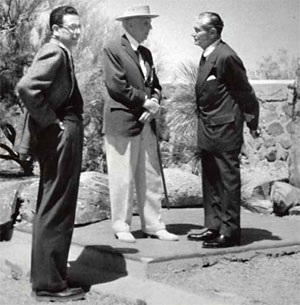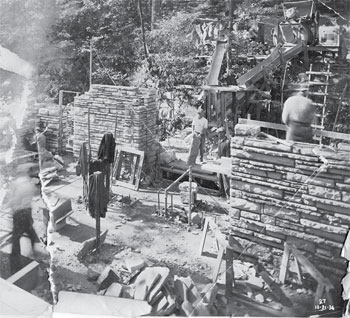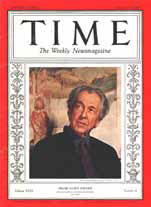A Milestone for Wright’s Masterwork
The year 2011 marks the 75th anniversary of Fallingwater, the icon of modern architecture that Frank Lloyd Wright designed and built above a waterfall in Fayette County, Pa.
A testament to the genius of Wright, Fallingwater was made possible by the Kaufmann family of Pittsburgh, who commissioned it as their weekend home. The family had proposed that Wright locate the structure near the waterfall that they loved on their extensive, forested property within Pennsylvania’s Laurel Highlands.
Wright responded with a dramatic design that placed the house over the falls, as opposed to next to them. “I want you to live with the waterfall, not just to look at it, but for it to become an integral part of your lives,” Wright told the Kaufmanns.

From left: Edgar Kaufmann jr., Frank Lloyd Wright and Edgar Kaufmann Sr. - Copyright Pedro E. Guerrero
Despite some initial misgivings about the plan, the Kaufmanns proved to be ideal clients for Wright. They agreed to move forward with his radical design, which called for a series of reinforced concrete trays cantilevered dramatically over the stream and falls, and separated from each other by locally quarried sandstone piers. Inside the house, expansive horizontal windows would run seamlessly into stone, connecting interior spaces to the abundant hemlocks, rhododendron and stone outcroppings of Fallingwater’s lush outdoor setting at every turn.
Fallingwater was completed in 1937, and it became famous almost immediately, gracing the cover of Time magazine in 1938. The house’s guest and service wing was completed in 1939.
Fallingwater solidified Wright’s reputation, then flagging, as an architect of unsurpassed daring and talent.
A work of art as well as architecture, Fallingwater remains as surprising and awe-inspiring today as it did when Edgar Kaufmann Sr., Liliane Kaufmann, and their son, Edgar Kaufmann jr., first set foot on its polished stone floors 75 years ago. Considered the world’s most famous private residence, Fallingwater exemplifies Wright’s concept of organic architecture, the harmonious union of art and nature.
Fallingwater’s “Life of Public Service”

Fallingwater under construction
Visitors to Fallingwater –– more than 160,000 in 2010 — might be surprised to know that the Western Pennsylvania Conservancy was reluctant at first to assume trusteeship of the site from Edgar Kaufmann jr. nearly half a century ago.
Well aware of Wright’s genius, Conservancy board members knew, too, that historic buildings often are expensive and difficult to maintain. “Historic preservation wasn’t what the Conservancy was into, and they feared it would be an albatross, that it would sink them,” said Lynda Waggoner, director of Fallingwater and a WPC vice president. “They looked at Edgar’s offer long and hard.”
No one could have anticipated then that Wright’s masterpiece would become one of the world’s most revered and popular house museums, a success Waggoner attributes to WPC’s dynamic stewardship of Kaufmann’s pioneering vision.
Kaufmann also was certain that WPC was the ideal trustee for the home his parents had lived in and loved. “Preservation is stopping life to serve a future contingency; conservation is keeping life going,” Kaufmann said at the dedication on Oct. 23, 1963. “As the waterfall of Bear Run needed the house to enter the realm of art… Fallingwater in its setting needed Western Pennsylvania Conservancy to enter a new life of public service.”
A curator of design at the Museum of Modern Art, architectural historian and adjunct professor at Columbia University, and Wright apprentice, Kaufmann mentored Fallingwater staff in the early years of the house museum, as revenues met expenses and attendance began to grow from 20,000 to 70,000 visitors annually.
As her own role at Fallingwater expanded over the years, so did the number of staff who would work with Waggoner in fulfilling Kaufmann’s dream. Many were local and remain so to this day, which is consistent with the Kaufmann family’s strong connections to the mountain community. Employee pride in the house and its original owners enhances the visitor experience, according to Denise Miner, public tour supervisor, whose relatives and neighbors helped build and care for the house.

“The Kaufmanns were well-liked and respected among local people,” said Miner. “Edgar Sr. kept dairy cattle — my uncle was his herdsman — and he helped organize other farmers into a ‘co-op’ so they could get better prices for their milk. Every once in a while, you’ll still come across a Mountain Top Co-op milk bottle.”
Miner grew up hearing how Edgar Sr. visited her grandparents’ kitchen for homemade angelfood cake and coffee. “Here was this world traveler and successful businessman who entertained Albert Einstein, yet felt close enough to neighborhood farmers to sit at their tables,” said Miner. “Mrs. Kaufmann would distribute Christmas stockings filled with candy and oranges to local children. Oranges in those days were a real treat.”
WPC today invites Fayette County residents to tour Fallingwater for free, through school tours and during county appreciation days every fall, Miner said. “Besides introducing children to architecture and art, we want to continue to instill a sense of pride in this unique and wonderful place in their own community.”
